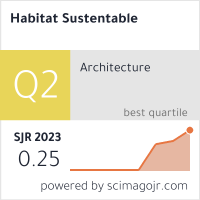Uso de água residual do ar condicionado e de agua pluvial como gestão da oferta em uma edificação comercial: estudo de caso
Palabras clave:
aproveitamento de água de chuva, construções verdes, sustentabilidadeResumen
O conceito do uso racional para a conservação de água consiste na gestão da demanda e da oferta de água, com ações voltadas para o fornecimento de fontes alternativas visando suprir o uso em áreas menos nobres por águas de qualidade inferior. Este trabalho tem por objetivo mostrar a aplicação de um sistema que aproveita a água drenada dos evaporadores de ar-condicionado e das águas pluviais como fontes alternativas. Verificou-se que cada evaporador produz 4,8 litros/água/hora, considerando 10 horas de uso diário, o volume acumulado chegaria a 48 litros/dia por aparelho que multiplicado pelo total de 137 unidades chega-se ao volume diário de 4.298 litros o que representa 77,72% da demanda das descargas sanitárias que é de 5.530 litros/dia. Em relação ao aproveitamento de águas pluviais, a previsão de acumulação refere-se a 10% da área do terreno que multiplicado pelo índice de 0,05 e pela retenção de 1 hora, obtém o volume de 14,8 m3 . Pretende-se com essa prática, alcançar uma redução significativa do volume de água potável, hoje utilizada praticamente para a realização de todas as atividades, contribuindo assim para uma obra mais sustentável, minimizando os impactos ambientais causados pela construção.
Descargas
Descargas
Publicado
Cómo citar
Número
Sección
Licencia
El contenido de los artículos que se publican en cada número de Hábitat Sustentable, es responsabilidad exclusiva de los autores y no representan necesariamente el pensamiento ni comprometen la opinión de la Universidad del Bío-Bío.
Los autores/as conservarán sus derechos de autor y garantizarán a la revista el derecho de primera publicación de su obra, el cuál estará simultáneamente sujeto a la Licencia de Reconocimiento de Creative Commons CC BY-SA que permite a otros compartir-copiar, transformar o crear nuevo material a partir de esta obra con fines no comerciales, siempre y cuando se reconozcan la autoría y la primera publicación en esta revista, y sus nuevas creaciones estén bajo una licencia con los mismos términos.











 Programa de Información Científica/Concurso Fondos de Publicación de Revistas Científicas 2018/ Proyecto Mejoramiento de Visibilidad de Revistas UBB (Código:FP180007)
Programa de Información Científica/Concurso Fondos de Publicación de Revistas Científicas 2018/ Proyecto Mejoramiento de Visibilidad de Revistas UBB (Código:FP180007) 





